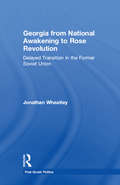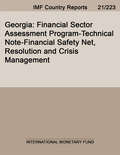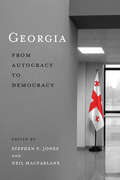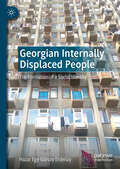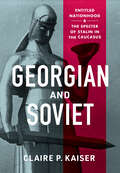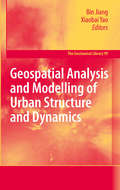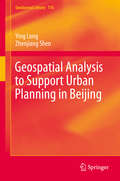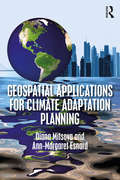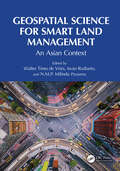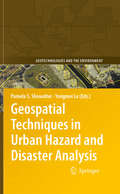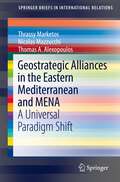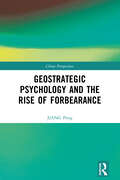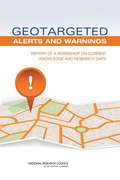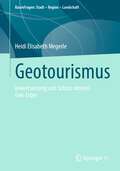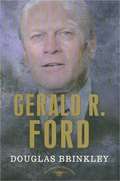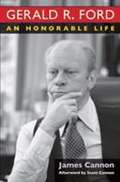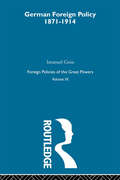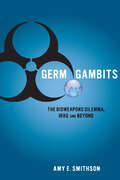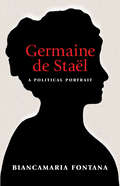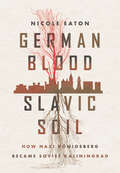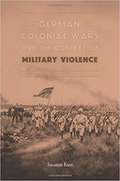- Table View
- List View
Georgia from National Awakening to Rose Revolution: Delayed Transition in the Former Soviet Union (Post-Soviet Politics)
by Jonathan WheatleyJonathan Wheatley examines the tortuous process of regime change in Georgia from the first pro-independence protests of 1988 to the aftermath of the so-called Rose Revolution in 2004. It is set within a comparative framework that includes other transition countries, particularly those in the former Soviet Union. The book provides two important theoretical innovations: the notion of a regime, which is an under-theorized concept in the field of transition literature, and O'Donnell, Schmitter and Karl's notion of a dynamic actor-driven transition. The volume turns to the structural constraints that framed the transition in Georgia and in other republics of the former Soviet Union by looking at the state and society in the USSR at the close of the Soviet period. It examines the evolution and nature of the Georgian regime, and ultimately addresses the theoretical and empirical problems posed by Georgia's so-called Rose Revolution following the falsification of parliamentary elections by the incumbent authorities.
Georgia: Estonia 1994 (Imf Economic Reviews Ser. #Country Report No. 15/8)
by International Monetary Fund. Monetary and Capital Markets DepartmentA report from the International Monetary Fund.
Georgia: From Autocracy to Democracy (Thirdworlds Ser.)
by Stephen F. Jones Neil MacFarlaneReflecting on the deep and complex changes in Georgian politics over the last quarter of a century, this book highlights the domestic and international developments that have shaped Georgia as a state and society. Georgia: From Autocracy to Democracy covers a wide array of topics, including the economy, elections, judicial and educational systems, relations with the European Union, and Georgia’s interaction with its regional neighbours, including Russia, Turkey, and Iran. In the book, Georgian policy-makers, practitioners, and scholars who have worked in the administration, in the opposition, in the Third Sector, and in academia provide first-hand perspectives on Georgia’s political and economic life. They demonstrate exceptional insight into the extraordinary transformations in Georgia over the last twenty-five years, from the authoritarianism of President Zviad Gamsakhurdia, through the experience of civil war in the 1990s, to democracy today.
Georgian Internally Displaced People: The Formation of a Social Identity
by Hazar Ege Gürsoy ErdenayThis book explores the construction of Internally Displaced Persons (IDPs) identity as a social group in Georgia, framed through Tajfel and Turner's Social Identity Theory. It examines the key factors shaping the identity of Georgian IDPs displaced by ethnic conflicts in two major migration waves (the early 1990s and 2008) from Abkhazia and South Ossetia. Divided into two parts, the study first looks at the historical context of the ethnic conflicts and the state's responses to displacement. The second part focuses on the formation of IDP identity, analyzing how external definitions by the host community have perpetuated devaluation? throughout the post-Soviet period. It also highlights the self-perceptions, characteristics and tactics that have helped transform IDP identity from a devalued label to a more positive and resilient social identity.
Georgian and Soviet: Entitled Nationhood and the Specter of Stalin in the Caucasus
by Claire P. KaiserGeorgian and Soviet investigates the constitutive capacity of Soviet nationhood and empire. The Soviet republic of Georgia, located in the mountainous Caucasus region, received the same nation-building template as other national republics of the USSR. Yet Stalin's Georgian heritage, intimate knowledge of Caucasian affairs, and personal involvement in local matters as he ascended to prominence left his homeland to confront a distinct set of challenges after his death in 1953.Utilizing Georgian archives and Georgian-language sources, Claire P. Kaiser argues that the postwar and post-Stalin era was decisive in the creation of a "Georgian" Georgia. This was due not only to the peculiar role played by the Stalin cult in the construction of modern Georgian nationhood but also to the subsequent changes that de-Stalinization wrought among Georgia's populace and in the unusual imperial relationship between Moscow and Tbilisi. Kaiser describes how the Soviet empire could be repressive yet also encourage opportunities for advancement—for individual careers as well as for certain nationalities. The creation of national hierarchies of entitlement could be as much about local and republic-level imperial imaginations as those of a Moscow center.Georgian and Soviet reveals that the entitled, republic-level national hierarchies that the Soviet Union created laid a foundation for the claims of nationalizing states that would emerge from the empire's wake in 1991. Today, Georgia still grapples with the legacies of its Soviet century, and the Stalin factor likewise lingers as new generations of Georgians reevaluate the symbiotic relationship between Soso Jughashvili and his native land.
Georgiana
by Amanda ForemanThe winner of Britain's prestigious Whitbread Prize and a bestseller there for months, this wonderfully readable biography offers a rich, rollicking picture of late-eighteenth-century British aristocracy and the intimate story of a woman who for a time was its undisputed leader.Lady Georgiana Spencer was the great-great-great-great-aunt of Diana, Princess of Wales, and was nearly as famous in her day. In 1774, at the age of seventeen, Georgiana achieved immediate celebrity by marrying one of England's richest and most influential aristocrats, the Duke of Devonshire. Launched into a world of wealth and power, she quickly became the queen of fashionable society, adored by the Prince of Wales, a dear friend of Marie-Antoinette, and leader of the most important salon of her time. Not content with the role of society hostess, she used her connections to enter politics, eventually becoming more influential than most of the men who held office. Her good works and social exploits made her loved by the multitudes, but Georgiana's public success, like Diana's, concealed a personal life that was fraught with suffering. The Duke of Devonshire was unimpressed by his wife's legendary charms, preferring instead those of her closest friend, a woman with whom Georgiana herself was rumored to be on intimate terms. For over twenty years, the three lived together in a jealous and uneasy ménage à trois, during which time both women bore the Duke's children--as well as those of other men.Foreman's descriptions of Georgiana's uncontrollable gambling, all- night drinking, drug taking, and love affairs with the leading politicians of the day give us fascinating insight into the lives of the British aristocracy in the era of the madness of King George III, the American and French revolutions, and the defeat of Napoleon. A gifted young historian whom critics are already likening to Antonia Fraser, Amanda Foreman draws on a wealth of fresh research and writes colorfully and penetratingly about the fascinating Georgiana, whose struggle against her own weaknesses, whose great beauty and flamboyance, and whose determination to play a part in the affairs of the world make her a vibrant, astonishingly contemporary figure.
Geospatial Analysis and Modelling of Urban Structure and Dynamics
by Bin Jiang Xiaobai YaoThe increasingly urbanized world has created various problems of environment, climate, consumption of resources, and public health, which are closely linked to the side-effects of urbanization such as sprawl, congestion, housing affordability and loss of open space. Fundamental to the urban problems are two separate yet related issues: urban structure and urban dynamics. The chapters collected in this book present an excellent profile of the current state of geospatial analysis and modelling, and demonstrate how these approaches can contribute to the study of various urban issues. The book addresses key themes including new ways of capturing data digitally at the individual level, the development of systems based around networks, the notion of linking hierarchy to networks to morphology as in complexity theory, and the development of new ways of integrating diverse urban processes through simulation paying careful attention to the basic econometric and statistical principles of spatial analysis. With a foreword by Michael Batty and an epilog by Michael F. Goodchild.
Geospatial Analysis to Support Urban Planning in Beijing
by Ying Long Zhenjiang ShenThis book describes a comprehensive framework of novel simulation approaches, conventional urban models, and related data mining techniques that will help develop planning support systems in Beijing as well as other mega-metropolitan areas. It investigates the relationships between human behaviors and spatial patterns in order to simulate activities in an urban space, visualize planning alternatives, and support decision making. The book first explains urban space using geometric patterns, such as points, networks, and polygons, that help identify patterns of household and individual human behavior. Next, it details how novel simulation methodologies, such as cellular automaton and multi-agent systems, and conventional urban modeling, such as spatial interaction models, can be used to identify an optimal or a simulated solution for a better urban form. The book develops a comprehensive land use and transportation integrated model used to explore the spatial patterns of mutual interaction between human mobility and urban space. This model can help forecast the distribution of different types of households, rent prices, and land prices, as well as the distribution of routes and traffic volume based on an appraisal of labor demand and supply. This book shows how geospatial analysis can be a useful tool for planners and decision makers to help in ascertaining patterns of activities and support urban planning. Offering both novel and conventional approaches to urban modeling, it will appeal to researchers, students, and policy makers looking for the optimal way to plan the d evelopment of a mega-metropolitan area.
Geospatial Applications for Climate Adaptation Planning
by Diana Mitsova Ann-Margaret EsnardClimate adaptation is a timely yet complex topic that does not fit squarely into any one disciplinary realm. Geospatial Applications for Climate Adaptation Planning presents an overview of the range of strategies, tools, and techniques that must be used to assess myriad overlapping vulnerabilities and to formulate appropriate climate-relevant solutions at multiple scales and in varying contexts. Organized into four sections, the book includes 15 chapters. Each chapter is grounded in the literature and presents case studies designed by the authors, as well as many examples from a diverse international group of scholars and entities in the public and private sectors. Areas covered include: Climate Change and Climate Adaptation Planning: Context and Concepts Geospatial Technologies: Fundamentals and Terminology GIS and Climate Vulnerability Assessments Technical Approaches to Formulating Mitigation and Adaptation Strategies Geospatial Applications for Climate Adaptation Planning is aimed at advanced students, researchers, and entities in the public and private sectors. It also provides supplementary reading for courses in planning, public administration, policy studies, and disaster management.
Geospatial Science for Smart Land Management: An Asian Context
by Walter Timo de Vries Iwan Rudiarto N.M.P. Milinda PiyasenaResponsible land distribution in Asia, with ever-increasing limitations in space, requires the use of smart technologies, sophisticated models, intelligent algorithms, and big data repositories. This book presents new land management perspectives and fit-for-purpose, flexible, dynamic, and effective solutions for land management and land administration problems. Written by global experts from different Asian countries, including China, India, Indonesia, Iran, Japan, South Korea, Thailand, Vietnam, etc., all these cases demonstrate how and why the uptake of geospatial technologies is booming and how to handle land scarcity and competing spatial interests in both urban and rural areas in Asia. FEATURES Summarizes trends of geospatial technologies in Asia Describes and applies leading-edge geospatial models Explains fit-for-purpose digital land administration Provides case studies and examples that include the use of smart land management tools Helps readers advance their understanding of geospatial and land management science Truly an interdisciplinary book, this text is a practical guide for an array of readers, such as practitioners in public and private companies involved in both geospatial and land management applications, as well as graduate students, researchers, academics, and professionals working in land administration, land management, spatial planning, real estate studies, geosciences, geoinformatics, and geodesy.
Geospatial Techniques in Urban Hazard and Disaster Analysis
by Pamela S. Showalter Yongmei LuThis book examines how Geographic Information Technologies (GIT) are being implemented to improve our understanding of a variety of hazard and disaster situations. The volume is a compilation of recent research using Geographic Information Systems (GIS), Remote Sensing (RS) and other technologies such as Global Positioning Systems (GPS) to examine urban hazard and disaster issues. The goal is to improve and advance the use of such technologies during four classic phases of hazard and disaster research: response, recovery, preparation and mitigation. The focus is on urban areas, broadly defined in order to encompass rapidly growing and densely populated areas. The material presented is multidisciplinary, with contributions from scholars in Africa, Asia, Europe, Latin America and North America, and is presented in five key sections: sea level rise and flood analysis earthquakes and tsunamis and international applications hurricane response/recovery metropolitan case studies evacuation studies This volume contributes to our understanding of extreme events in urban environments with the use of GIT and expanding its role at the local, regional, state and federal levels. The book is a valuable reference for academic researchers and professionals and practitioners working in hazard management and mitigation.
Geostrategic Alliances in the Eastern Mediterranean and MENA: A Universal Paradigm Shift (SpringerBriefs in International Relations)
by Thrassy Marketos Nicolas Mazzucchi Thomas A. AlexopoulosThis book examines the geostrategic alliances in the Eastern Mediterranean and MENA regions. It analyzes how these alliances transcend stereotyped political and cultural prototypes throughout western Eurasia as the outcome of shifting regional power balances. The authors explain how this development has its foundation mostly in the United States' ‘Pivot to Asia’ policy, resulting in a lower priority ranking of the Middle East for Washington, but also in the emergence of China’s economic incursion on the wider region. The book looks into and presents different reasons for this paradigm shift: First and foremost, the historical ambitions and conflicting assertions of sovereignty in the region. Then, competition over control of hydrocarbons reserves and pipeline politics, civil wars, and political chaos in certain littoral states. US retrenchment and Russia’s naval base expansion in Syria, as well as Turkish expansion in Libya, NATO allies divisions and, not to reckon with, waves of migration and refugees. Yet some internal and external factors could lead to some changes in these trends, including the need to engage in energy transitions due to climate change consequences in the region. Therefore, this book is a must-read for scholars, students, policy-makers, and practitioners interested in a better understanding of the political development in the Eastern Mediterranean and MENA regions, as well as of International Relations in general.
Geostrategic Psychology and the Rise of Forbearance (China Perspectives)
by JIANG PengBased on the framework of geostrategic psychology, this book elucidates the intrinsic law of the rise and fall of great powers and gives insights into the quandary of China's rise and the mechanism behind the strategy.Conflating geopolitics and strategic psychology, geostrategic psychology is rooted in the historical study of strategy and premised on an assumption that human beings bear resemblance in psychology and behavior when facing the same structure of geopolitical circumstance. The book analyzes intriguing phenomena from strategic psychology, including trend anxiety and conflict willingness, the Old Man Phenomenon in international politics, the Santa Claus Effect, the Myth of the Sunk Cost Fallacy, Bidder Myth, Gambler's Game, Philip Trap, William's Dilemma, Heartland Myth, Domino's Fear, Golden Nation Myth, Alliance Commitment Dilemma and Corinthian Dilemma among others. The author combines theory, history and the practice of international politics, revealing how a nation can occupy a favorable position in the field of global strategic competition and prospects for China.The title will be a valuable reference for observers of international politics as well as researchers and students interested in international relations, international politics, geopolitics, strategic psychology and geostrategic psychology.
Geotargeted Alerts and Warnings
by National Research Council Computer Science and Telecommunications Board Division on Engineering and Physical Sciences Committee on Geotargeted Disaster Alerts and Warnings: A Workshop on Current Knowledge and Research GapsGeotargeted Alerts and Warnings: Report of a Workshop on Current Knowledge and Research Gaps is the summary of a February, 2013 workshop convened by the Computer Science and Telecommunications Board of the National Research Council to examine precise geotargeting of public alerts and warnings using social media. The workshop brought together social science researchers, technologists, emergency management professionals, and other experts to explore what is known about how the public responds to geotargeted alerts and warnings, technologies and techniques for enhancing the geotargeting of alerts and warnings, and open research questions about how to effectively use geotargeted alerts and warnings and technology gaps. This report considers the potential for more precise geographical targeting to improve the effectiveness of disaster alerts and warnings; examines the opportunities presented by current and emerging technologies to create, deliver, and display alerts and warnings with greater geographical precision; considers the circumstances where more granular targeting would be useful; and examines the potential roles of federal, state, and local agencies and private sector information and communications providers in delivering more targeted alerts.
Geotourismus: Inwertsetzung und Schutz unseres Geo-Erbes (RaumFragen: Stadt – Region – Landschaft)
by Heidi Elisabeth MegerleGeotourismus, lange als eine Form des Nischentourismus betrachtet, hat sich zu einer nachgefragten Form des Thementourismus entwickelt. Im letzten Jahrzehnt erwies sich Geotourismus sogar als das am schnellsten wachsende Tourismussegment. Geoparks sind die wesentlichen Träger des Geotourismus. Sie sind keine zusätzliche Naturschutzkategorie, sondern eine Prädikatisierung für Gebiete, die ein herausragendes Geopotential aufweisen sowie eine Strategie zur nachhaltigen Regionalentwicklung. Ihre spezifischen Geotope und Geolandschaften (Geodiversität) nutzen sie für ein geotouristisches Standortmarketing. Über Geobildung wird Interesse für geotouristische Angebote geweckt und ein Bewusstsein für den Geotopschutz aufgebaut, der nach wie vor ein Stiefkind des Naturschutzes ist. Bereits seit dem Jahr 2000 besteht das Netzwerk der European Geoparks. In Deutschland können zusätzlich Nationale GeoParks anerkannt werden. 2015 wurde mit den UNESCO Global Geoparks eine weitere Kategorie von UNESCO Stätten – neben den Welterbestätten und den Biosphärenreservaten – ins Leben gerufen. Als Modellregionen für nachhaltige Entwicklung sollen sie aufzeigen, wie Ziele der globalen Nachhaltigkeitsagenda 2030 auf kommunaler und regionaler Ebene umgesetzt werden können.
Gerald Ford and the Challenges of the 1970s
by Yanek MieczkowskiA reappraisal of the brief presidency of Gerald Ford, called to leadership in the midst of scandal, stagflation, and an energy crisis. For many Americans, Gerald Ford evokes an image of either an unelected president who abruptly pardoned his corrupt predecessor or an accident-prone klutz spoofed on Saturday Night Live. In this book, Yanek Mieczkowski reexamines Ford&’s two and a half years in office, showing that his presidency successfully confronted the most vexing crisis of the postwar era. Viewing the 1970s primarily through the lens of economic events, Mieczkowski argues that Ford&’s understanding of the national economy was better than any modern president&’s; that he oversaw a dramatic reduction of inflation; and that he attempted to solve the energy crisis with judicious policies. Throughout his presidency, Ford labored under the legacy of Watergate. Democrats scored landslide victories in the 1974 midterm elections, and within an anemic Republican Party, the right wing challenged Ford&’s leadership, even as pundits predicted the GOP&’s death. Yet Ford reinvigorated the party and fashioned a 1976 campaign strategy against Jimmy Carter that brought him from thirty points behind to a dead heat on election day. Drawing on numerous personal interviews with former President Ford, cabinet officials, and members of the Ninety-fourth Congress, Mieczkowski presents the first major work on Ford in more than a decade, combining the best of biography and presidential history to paint an intriguing portrait of a president, his times, and his legacy. &“This ambitious work calls for a reexamination of the Ford presidency in light of the formidable challenges he faced upon taking office. A welcome and important addition to the literature on the Ford presidency.&” ―Library Journal
Gerald R. Ford (The American Presidents Series)
by Arthur M. Schlesinger Douglas G. BrinkleyThe 'accidental' president whose innate decency and steady hand restored the presidency after its greatest crisis. When Gerald R. Ford entered the White House in August 1974, he inherited a presidency tarnished by the Watergate scandal, the economy was in a recession, the Vietnam War was drawing to a close, and he had taken office without having been elected. Most observers gave him little chance of success, especially after he pardoned Richard Nixon just a month into his presidency, an action that outraged many Americans, but which Ford thought was necessary to move the nation forward. Many people today think of Ford as a man who stumbled a lot--clumsy on his feet and in politics--but acclaimed historian Douglas Brinkley shows him to be a man of independent thought and conscience, who never allowed party loyalty to prevail over his sense of right and wrong. As a young congressman, he stood up to the isolationists in the Republican leadership, promoting a vigorous role for America in the world. Later, as House minority leader and as president, he challenged the right wing of his party, refusing to bend to their vision of confrontation with the Communist world. And after the fall of Saigon, Ford also overruled his advisers by allowing Vietnamese refugees to enter the United States, arguing that to do so was the humane thing to do. Brinkley draws on exclusive interviews with Ford and on previously unpublished documents (including a remarkable correspondence between Ford and Nixon stretching over four decades), fashioning a masterful reassessment of Gerald R. Ford's presidency and his under-appreciated legacy to the nation.
Gerald R. Ford: An Honorable Life
by James Scott Cannon“Not since Harry Truman succeeded Franklin D. Roosevelt twenty-nine years earlier had the American people known so little about a man who had stepped forward from obscurity to take the oath of office as President of the United States. ” —from Chapter 4 This is a comprehensive narrative account of the life of Gerald Ford written by one of his closest advisers, James Cannon. Written with unique insight and benefiting from personal interviews with President Ford in his last years, Gerald R. Ford: An Honorable Life is James Cannon’s final look at the simple and honest man from the Midwest.
Gerald R. Ford: Thirty-eighth President Of The United States
by David R. CollinsPresents the life of Gerald Ford, including his childhood, education, employment, and political career.
Germ Foreign Pol 1871-1914 V9
by GeissFirst Published in 2001. Routledge is an imprint of Taylor & Francis, an informa company.
Germ Gambits
by Amy E. SmithsonArms control and nonproliferation treaties are among the fingers in the dike preventing the unthinkable nuclear, biological, and chemical catastrophe. For decades the ability to ascertain whether states are hiding germ weapons programs has been nonexistent because the 1975 bioweapons ban has no inspection measures. Yet, in 1995 a small United Nations inspection corps pulled off a spectacular verification feat in the face of concerted resistance from Iraq's Saddam Hussein and popular skepticism that it was even possible to conduct effective biological inspections. Working from sketchy intelligence—and hampered by the Iraqis' extensive concealment and deception measures—the inspectors busted open Iraq's cover stories and wrested a confession of biowarfare agent production from Baghdad. This rigorously researched book tells that compelling story through the firsthand accounts of the inspectors who, with a combination of intrepidness, ingenuity, and a couple of lucky breaks, took the lid off Iraq's bioweapons program and pulled off an improbable victory for peace and international security. The book concludes by drawing lessons from this experience that should be applied to help arrest future bioweapons programs, by placing the Iraq bioweapons saga in the context of other manmade biological risks, and by making recommendations to reduce those risks. While written as an engaging, analytical historical narrative that explains what the biological inspectors knew, when and how they knew it, and how they outmaneuvered the Iraqis, this book's real contributions are the inspectors' blueprint to "get it right" with regard to the verification challenges associated with the bioweapons ban, and the author's roadmap to address the overall biological threats facing the world today.
Germaine de Stael: A Political Portrait
by Biancamaria FontanaGermaine de Staël (1766-1817) is perhaps best known today as a novelist, literary critic, and outspoken and independent thinker. Yet she was also a prominent figure in politics during the French Revolution. Biancamaria Fontana sheds new light on this often overlooked aspect of Staël's life and work, bringing vividly to life her unique experience as a political actor in a world where women had no place.The banker's daughter who became one of Europe's best-connected intellectuals, Staël was an exceptionally talented woman who achieved a degree of public influence to which not even her wealth and privilege would normally have entitled her. During the Revolution, when the lives of so many around her were destroyed, she succeeded in carving out a unique path for herself and making her views heard, first by the powerful men around her, later by the European public at large. Fontana provides the first in-depth look at her substantial output of writings on the theory and practice of the exercise of power, setting in sharp relief the dimension of Staël's life that she cared most about--politics. She was fascinated by the nature of public opinion, and believed that viable political regimes were founded on public trust and popular consensus. Fontana shows how Staël's ideas were shaped by the remarkable times in which she lived, and argues that it is only through a consideration of her political insights that we can fully understand Staël's legacy and its enduring relevance for us today.
German Blood, Slavic Soil: How Nazi Königsberg Became Soviet Kaliningrad (Battlegrounds: Cornell Studies in Military History)
by Nicole EatonGerman Blood, Slavic Soil reveals how Nazi Germany and the Soviet Union, twentieth-century Europe's two most violent revolutionary regimes, transformed a single city and the people who lived there. During World War II, this single city became an epicenter in the apocalyptic battle between their two regimes.Drawing on sources and perspectives from both sides, Nicole Eaton explores not only what Germans and Soviets thought about each other, but also how the war brought them together. She details an intricate timeline, first describing how Königsberg, a seven-hundred-year-old German port city on the Baltic Sea and lifelong home of Immanuel Kant, became infamous in the 1930s as the easternmost bastion of Hitler's Third Reich and the launching point for the Nazis' genocidal war in the East. She then describes how, after being destroyed by bombing and siege warfare in 1945, Königsberg became Kaliningrad, the westernmost city of Stalin's Soviet Union. Königsberg/Kaliningrad is the only city to have been ruled by both Hitler and Stalin as their own—in both wartime occupation and as integral territory of the two regimes. German Blood, Slavic Soil presents an intimate look into the Nazi-Soviet encounter during World War II. Eaton impressively shows how this outpost city, far from the centers of power in Moscow and Berlin, became a closed-off space where Nazis and Stalinists each staged radical experiments in societal transformation and were forced to reimagine their utopias in dialogue with the encounter between the victims and proponents of the two regimes.
German Colonial Wars and the Context of Military Violence
by Susanne KussSome historians have traced a line from Germany’s atrocities in its colonial wars to those committed by the Nazis during WWII. Susanne Kuss dismantles these claims, rejecting the notion that a distinctive military ethos or policy of genocide guided Germany’s conduct of operations in Africa and China, despite acts of unquestionable brutality.
German Colonialism:
by Sebastian Conrad Sorcha O'HaganGermany was a latecomer to the colonial world of the late nineteenth century but this history of German colonialism makes clear the wide-reaching consequences of Germany's short-lived colonial project. Sebastian Conrad charts the expansion of the empire from its origins in the acquisition of substantial territories in present day Togo, Cameroon, Namibia and Tanzania to new settlements in East Asia and the Pacific and reveals the colonialist culture which permeated the German nation and its politics. Drawing on the wider history of European expansion and globalisation he highlights the close interactions and shared vocabularies of the colonial powers and emphasises Germany's major role in the period of high imperialism before 1914. Even beyond the official end of the empire in 1919 the quest for Lebensraum and the growth of the Nazi empire in Eastern Europe can be viewed within a framework of colonialism whose effects resonate to the present day.
